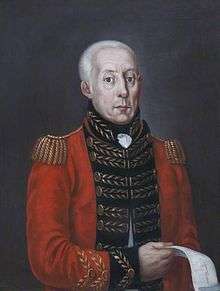Hugh Lyle Carmichael
Lt. General Sir Hugh Lyle Carmichael (1764–1813), was a British officer of the 2nd West India Regiment. He was Commander-in-Chief of the British Forces at the Siege of Santo Domingo. He was Lieutenant Governor of Demerara from 1812 until his death the following year. He was a strong proponent of giving native Caribbean troops the same rights as ordinary British soldiers.
Lt.-General Sir Hugh Lyle Carmichael | |
|---|---|
 Courtesy of the National Army Museum, London | |
| Born | 1764 Dublin, Ireland |
| Died | 11 May 1813 (aged 48) Demerara, Guyana |
| Allegiance | |
| Service/ | |
| Rank | Lieutenant General |
| Battles/wars | Battle of Grenada Siege of Santo Domingo (1808) |
| Other work | Lieutenant Governor of Demerara |
Born at Dublin, Ireland, in 1764, he was the son of Hugh Carmichael (1720–1776) and his wife Elizabeth, daughter of Hugh Lyle, of Coleraine, Co. Londonderry; formerly the Captain of a Regiment of Dragoons.[1] His grandfather, Andrew Carmichael (1675–1759), was the grandson of Samuel, brother of the 2nd Lord Carmichael. Andrew came from Scotland to Northern Ireland where he was Provost of Dungannon and married at Killyleagh his cousin, Anne Montgomery, niece of Hugh Montgomery, 1st Earl of Mount Alexander.[2] Carmichael's sister, Eleanor, married the son and heir of Theaker Wilder, nephew of James Steuart, Admiral of the Fleet.
Carmichael is noted for recognising the value and usefulness of incorporating native Caribbean troops into the British Army. In 1797, he wrote that they were not only critical militarily, but their strength and stamina had been proven by their having to carry British soldiers through the heat and over the rocks at the Battle of Grenada. He campaigned for the right of slave soldiers to give evidence at Military tribunals.[3] White and black soldiers alike were brutally flogged for violating military rules, but Carmichael found a more humane method to be equally as effective: During his eleven years as Lieutenant-Colonel of the 2nd West India Regiment, Carmichael instead demoted native offenders to a position resembling that of a common field slave – deprived of weapons and appointments and employed only on fatigue duties.[4]
Carmichael had started his military career as an Ensign in the 67th Regiment of Foot, and was promoted to Lieutenant in 1783.[5] He served as a Captain in Lord Strathaven's privately raised regiment, before returning to the British Regulars with the same rank in 1794.[6] In 1797, he was appointed Lieutenant-Colonel of the 2nd West India Regiment.[7]
In 1801, with Arthur Whetham, he was appointed full Colonel and Brigadier-General of the Leeward Islands.[8] In 1803, he was appointed Brigadier-General of Jamaica.[9] In 1808, now a Major-General, Carmichael was despatched to end the French occupation of Santo Domingo. In command of six frigates of the Royal Navy, Carmichael supported the Siege of Santo Domingo. In June 1809, in command of the 2nd West Indian, 54th, 55th, and Royal Irish regiments, Carmichael embarked from Polingue Bay, and persuaded General Juan Sánchez Ramírez to capture San Carlos Church on the outskirts of the capital, cutting off communication between Santo Domingo and Fort Jeronimo. Carmichael installed heavy siege batteries around the capital and massed his forces ready for an assault until the French surrendered, 9 July 1809.[10]
In 1812, he was appointed Lieutenant Governor of Demerara. Although he died in May the following year, he made several lasting changes in his short time as governor. In May 1812, he changed the name of the capital from Stabroek to Georgetown, in honour of George III. Dutch had been the official language of the courts but Carmichael ordered all legal documents to be written in both Dutch and English. His administration encountered stiff opposition from the Dutch planters who held influence at the Court of Policy, and particularly the College of Keizers, which was held to be their exclusive domain. Without even first receiving approval from Britain, Carmichael took decisive action and abolished the College of Keizers, handing over its duties to the Financial Representatives in the Court of Policy.[11] Towards the end of 1812, the United States of America went to war with Britain. In September, American warships formed a blockade around Georgetown. Under Carmichael, a British force stationed in Georgetown launched a successful attack on the Americans and drove them from Guyana's shores.[12]
Carmichael had married Catherine, the only surviving daughter and sole heiress of John Ferrall of Jervis Street, Dublin. In compliance with her father's will she became known as Lady Catherine Carmichael-Ferrall.[13] They were survived by one son, Colonel John Carmichael, father of Captain John Jervis O'Ferrall Carmichael-Ferrall (d.1904) RN, of Augher Castle, Co. Tyrone.[14]
References
- The ancestry of Rosalie Morris Johnson, published privately by Ferris & Leach, 1905
- Debrett, John (1823). Debrett's Peerage of England, Scotland, and Ireland. Oxford University. pp. xciv.
- National Army Museum
- The British Army in the West Indies, by Roger Buckley, 1998
- Remenbrancer, 1783
- The Scots Magazine, 1794
- A List of All the Officers of Army and Royal Marines on Full and Half-pay – C. Roworth, 1805
- Gentleman's Magazine, March 1801, volume 90
- Gentleman's Magazine, January 1803, Volume 73
- Wars of the Americas: A Chronology of Armed Conflict in the New World, 1492 to the Present. David Marley, 1998.
- The Beginning of British Guiana
- The Beginning of British Guiana
- The General Armory of England, Scotland, Ireland, and Wales, Comprising a Registry of Armorial Bearings from the Earliest to the Present Time. Bernard Burke, 2009
- Landed Estates Database